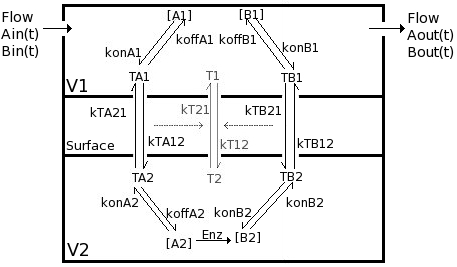Facilitating Transporter for 2 competing solutes including binding steps. Shows countertransport facilitation/inhibition. Substrate A is converted to B in region 2.
Figure

The input function Ain(t) = 1 mM, a constant. Solute A is transported from V1 to V2 by a transporter that can bind to either A or B. The transporter can flip from side to side in the unbound form T, or in the bound forms, TA and TB. In V2, A is converted to B by an irreversible Michaelis-Menten like process.
When the rate of flipping of the unbound transporter, T1 to T2 and vice versa, is less than the rate for the bound transporter, TA1, TB1, TA2, and TB2, then the presence of B2 in V2 facilitates the transfer of A from V1 to V2 because it augments the return into unbound T1 on side 1. This can be seen by the increase in transmembrane flux of A after 35-45 seconds when B2 has built up enough TB2 and TB1, which then delivers B to V1 giving more unbound T1 so A1 diminishes.
Description
Transp2sol.Comp2F is a six state transporter model for 2 solutes in competition Two solute species compete for the transporter site on either side of a membrane between two mixing chambers. In compartment 2, A is reacted to form B in an enzymatic reaction approximated by a Michaelis Menten expression, and without any accounting for binding of substrate or product to the enzyme. When the rates of conformational state change for transmembrane flipping of TA and TB are high compared to that for uncomplexed transporter T, then the model behaves much like an obligatory countertransporter, exchanging B for A across the membrane; With the initial substrate concentrations high compared to the transporter binding affinities, KdA or KdB, most of the transporter is bound and the system behaves as an obligatory countertransporter, though the gradient eventually dissipates. MODEL VERIFICATION: Total Mass is conserved: Substrate in solution is totaled as SubstrateV, and substrate bound to transporter as SubstrateM, for membrane bound.
Equations




Ordinary Differential Equations










Transporter Mass Conservation

Substrate Mass Conservation

WARNING: Thermodynamic constraint are not included in the model. For a passive transporter, the transport rate constants should satisfy the following constraints:

The equations for this model may be viewed by running the JSim model applet and clicking on the Source tab at the bottom left of JSim's Run Time graphical user interface. The equations are written in JSim's Mathematical Modeling Language (MML). See the Introduction to MML and the MML Reference Manual. Additional documentation for MML can be found by using the search option at the Physiome home page.
- Download JSim model MML code (text):
- Download translated SBML version of model (if available):
We welcome comments and feedback for this model. Please use the button below to send comments:
Klingenberg M. Membrane protein oligomeric structure and transport function. Nature 290: 449-454, 1981. Stein WD. The Movement of Molecules across Cell Membranes. New York: Academic Press, 1967. Stein WD. Transport and Diffusion across Cell Membranes. Orlando, Florida: Academic Press Inc., 1986. Wilbrandt W and Rosenberg T. The concept of carrier transport and its corollaries in pharmacology. Pharmacol Rev 13: 109-183, 1961. Schwartz LM, Bukowski TR, Ploger JD, and Bassingthwaighte JB. Endothelial adenosin transporter characterization in perfused guinea pig hearts. Am J Physiol Heart Circ Physiol 279: H1502-H1511, 2000. Foster DM and Jacquez JA. An analysis of the adequacy of the asymmetric carrier model for sugar transport. Biochim Biophys Acta 436: 210-221, 1976.
Please cite https://www.imagwiki.nibib.nih.gov/physiome in any publication for which this software is used and send one reprint to the address given below:
The National Simulation Resource, Director J. B. Bassingthwaighte, Department of Bioengineering, University of Washington, Seattle WA 98195-5061.
Model development and archiving support at https://www.imagwiki.nibib.nih.gov/physiome provided by the following grants: NIH U01HL122199 Analyzing the Cardiac Power Grid, 09/15/2015 - 05/31/2020, NIH/NIBIB BE08407 Software Integration, JSim and SBW 6/1/09-5/31/13; NIH/NHLBI T15 HL88516-01 Modeling for Heart, Lung and Blood: From Cell to Organ, 4/1/07-3/31/11; NSF BES-0506477 Adaptive Multi-Scale Model Simulation, 8/15/05-7/31/08; NIH/NHLBI R01 HL073598 Core 3: 3D Imaging and Computer Modeling of the Respiratory Tract, 9/1/04-8/31/09; as well as prior support from NIH/NCRR P41 RR01243 Simulation Resource in Circulatory Mass Transport and Exchange, 12/1/1980-11/30/01 and NIH/NIBIB R01 EB001973 JSim: A Simulation Analysis Platform, 3/1/02-2/28/07.

